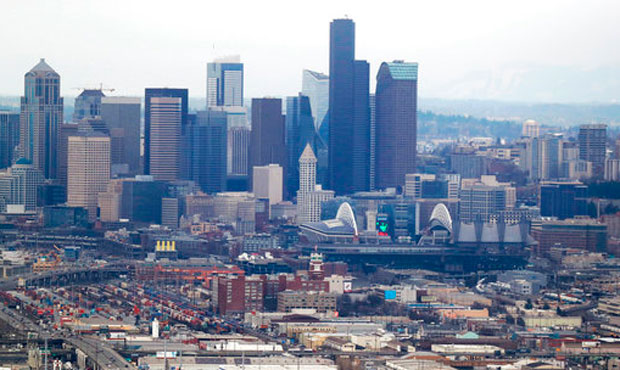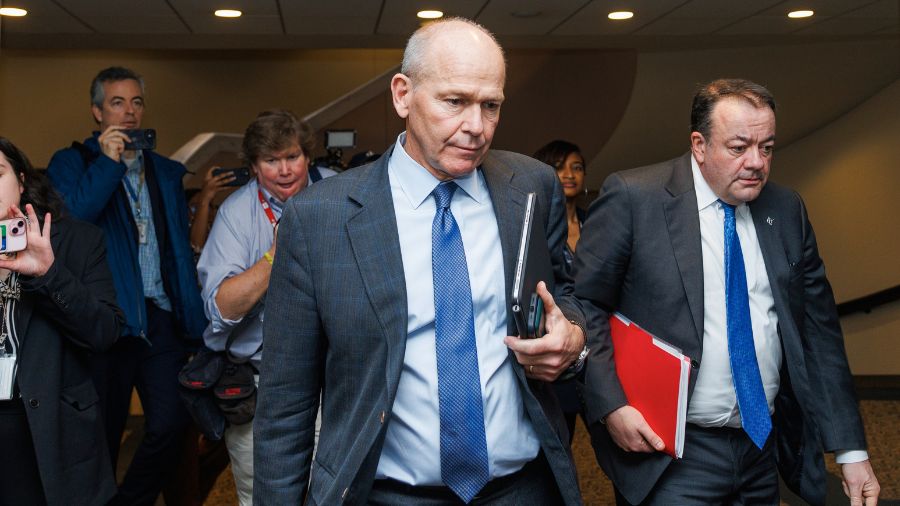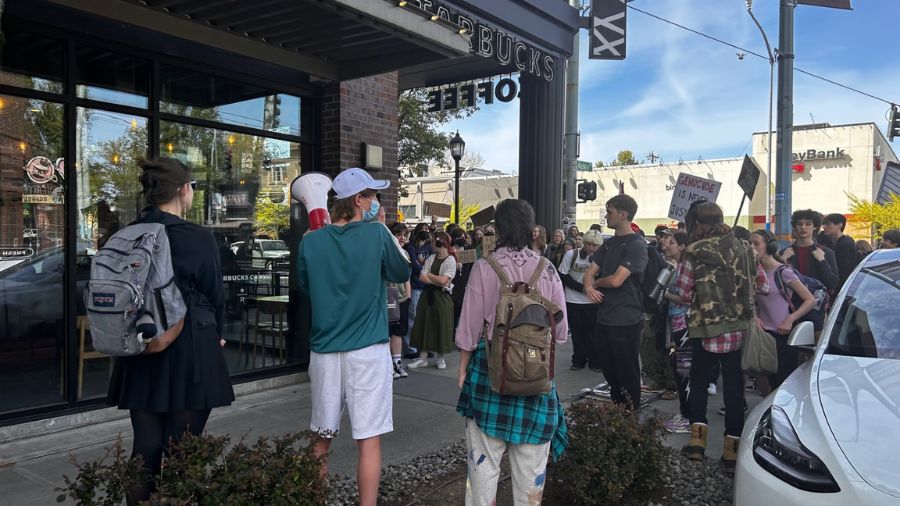Homeless response, BIPOC investments, public safety in first week of Seattle’s 2021 budget work
Oct 4, 2020, 8:32 AM

(AP Photo/Ted S. Warren)
(AP Photo/Ted S. Warren)
It was a busy week of budget work in Seattle that saw the end of the Navigation Team, the start of out-of-order layoffs at the Seattle Police Department, and potentially competing efforts to a reimaging of policing and public safety.
On Tuesday, Mayor Jenny Durkan rolled out her proposed 2021 budget proposal.
Faced with a major drop in revenue due to COVID-19 and increased spending needs, Durkan’s budget pulls more than $200 million dollars from the Seattle City Council, which passed the Jump Start tax on big business despite the mayor’s opposition. Durkan’s proposal is an effort to close the revenue gap left by significant drops in collections of B&O, sales, and other taxes.
The council had previously passed a resolution for how it wanted those dollars to be used, a split between covering $96 million in city services, $86 million to replenish reserve accounts, and another $26 million in COVID-19 relief.
Durkan also made good on her promise to invest $100 million dollars in BIPOC communities, but those dollars come from the general fund, not the Seattle Police Department. The investment quickly became a point of contention as the city council began pouring through the mayor’s proposal on Wednesday.
The money goes into a fund where it will sit until a task force, appointed by Durkan’s office, meets and comes up with where it determines the dollars can best be used.
Sean Goode, Executive Director of CHOOSE 180, a group that has long worked with the city and county prosecutor office on keeping youth and young adults from communities of color out of the criminal justice system, wrote an Op-ed about why he had already quit the mayor’s task force.
“Investment without divestment is a fruitless pursuit,” Goode said. “We can continue to pour more money into communities that are suffering, but if we’re not actually stopping the investment in things that are causing the harm, then what are we really doing with the dollars.”
“We’ve never questioned whether adding or growing the size of our police department actually increases safety because we, in government, assumed it does,” Councilmember Lisa Herbold said during a budget meeting this week, pointing to the significant growth in SPD’s budget in recent years, even increasing during the Great Recession when other departments were cut.
Herbold also pointed to a review of 911 calls in Seattle that the council requested over the summer. The review showed that 56 percent of those calls were non-criminal. It’s just some of the evidence informing the need to right size the SPD and find alternative responders and solutions.
Interim Seattle Police Chief Adrian Diaz explained during the meeting that while the department had seen an increased budget in recent years, much of that was to meet requirements of the consent decree, including many civilian positions. He noted that the SPD currently only has about 25 more patrol officers than it did in 2010.
“Since the inception of the consent decree, we’ve created 58 sworn positions to support that work along with additional civilian positions,” Diaz said, explaining that functionally, all of those positions are necessary to support the work and meet every requirement of the consent decree.
“On the street, that means we’re the same size that we were eight years ago,” Diaz said, adding that due to increases in officer leave, the SPD actually has 35 fewer cops on the street than it did in 2010.
Diaz reiterated that officers on patrol have consistently said they are stretched thin, continually having to race from call to call, which is why he recently shifted 100 detectives and officers out of specialty units to patrol, a shift that was completed Wednesday.
“I want to see what type of notch public safety services we can deliver when they have the time to address the real issues,” Diaz explained to the council.
The chief pointed out that the SPD consistently gets calls for more cops on the street to respond and address a variety of issues, especially after incidents like the mass shooting at Third and Pine in January.
Diaz said the SPD got calls from the community to increase the visible police presence in the problematic area after the shooting and did so at a cost $418,000, right up until the pandemic shut down, and adding that SPD was likely to continue to get calls for more officers in certain areas.
“Almost every year we’re asked to put more officers out along Alki to address loud cars, racing and partying,” Diaz explained to the council. “Almost every year we’re asked to have more officers in the Ballard Commons to address drug dealing and general disorder. Almost every year, we’re asked to do more along Rainier and other areas in the south end as they experience an unacceptable level of gun violence.”
Those comments highlight one of the backdrops of the overall conversation into reimagining public safety: division within the Black community about reimagined public safety, with views ranging from supporting current police levels to complete abolishment in favor of 100% community-led public safety. It’s a division that will come more into focus over the next several weeks as 2021 budget negotiations continue.
Overall, Durkan’s proposed 2021 spending plan shaves a little more than 12% off of SPD’s budget on paper — or about $50 million, which amounts to more than 330 fewer staff. The bulk of that is due to shifting the 911 call center and emergency operations management out of the SPD budget, while envisioning a police force of 1,400. That’s about 100 fewer than 2020’s budget.
Diaz told the council he wants the SPD to be part of the solution and fully supports moving functions out of the department that can exist elsewhere, as well as other changes that can happen once a critical review of responses is complete. However, Diaz also made it clear that any drop below 1,400 officers at SPD, in his view, would be problematic for the city.
“Each drop below [1,400 officers] will mean either slower response times, larger caseloads or types of crimes we can no longer respond to,” Diaz warned, adding that those issues will only snowball if the hiring freeze initiated in response to the pandemic continues into 2021.
“I do not have enough officers right now to handle the work we are asked to do,” Diaz said. “The call analysis will identify some of the work that can be shifted, but the alternative resources to handle those calls will not be there January 1, 2021. They won’t be there December 31, 2021. We have to bridge the difference.”
Council Budget Chair Teresa Mosqueda questioned that analysis, pointing out that the larger conversation about shifting certain calls away from SPD in favor of a mental health, traffic, or other non-armed response should mean a reduction in the size of the department.
“If we’re effectively having a conversation about transferring those calls into another area, is there not a willingness to recognize that the type of sworn officers — with guns –that number could inherently go down?” Mosqueda asked Diaz.
Short answer: No, at least according to Diaz, who stressed that SPD had already been stretched thin with staffing at 2010 levels. It’s why there has been the push to increase the size of the force for the past several years.
But council members felt that was tone deaf.
“I’m a little concerned that we’re starting this conversation from the place of it’s 1,400 officers or bust,” said Council President Lorena Gonzales, “I just don’t think that’s going to be helpful.”
Much of the conversation focused on the model that police departments determine staffing needs, which for Seattle is workload, but Gonzales suggested that way of thinking could hinder the wider effort of reimagining public safety.
It was the first round of discussions between the council and SPD on the 2021 budget, and promises to be a challenging discussion in the weeks ahead. They signal better cooperation between SPD and the council than the previous budget discussions on the 2020 rebalancing package, which excluded former Chief Carmen Best.
The council deliberations came as Mayor Durkan also issued an Executive Order to start the process of reviewing which SPD functions can be moved out of the department.
Also, last week the mayor took action on the 2020 rebalancing package the council voted to override her veto on, including immediate suspension of the Navigation Team and the beginning of 70 out-of-order layoffs of Seattle Police officers.
Durkan explained those would not happen by November, as the council wanted, because both the Seattle Police Officer’s Guild and Seattle Police Management Association demanded bargaining — a mere prelude of what’s to come as the city deals with negotiating a new contract with SPOG. That process is already several months overdue.
On Friday, the city council also took issue with Durkan’s 2021 proposal for a re-tooled Navigation Team.
Durkan’s budget includes a record $151.7 million in the city’s homeless response, including money for a re-worked Navigation Team that cuts in half the number of city funded outreach workers but does not include any full-time Seattle Police Officers.
That part of the proposal became an issue for some on the council Friday who, after pushing the mayor’s staff at the briefing, learned that could include SPD still being involved in clearing hazardous encampments. It’s one of the major complaints about the former Navigation Team.
The city council will continue sifting through the budget proposal on Monday.













